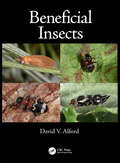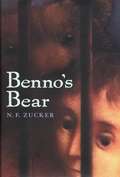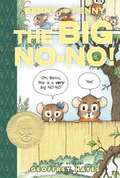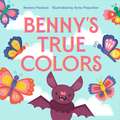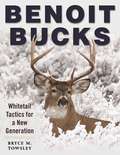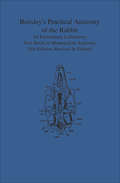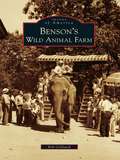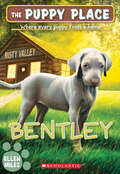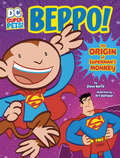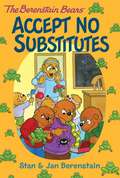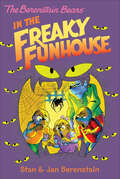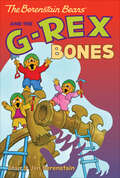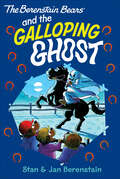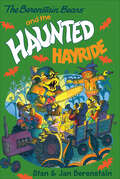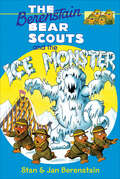- Table View
- List View
Beneath the Texas Moon (Eclipse Ser. #17)
by Elle JamesA single mom and a rugged rancher team up when danger stalks their Texas town in this romantic suspense tale by a New York Times–bestselling author.Eve Baxter thought tiny Spirit Canyon, Texas, was the perfect place to escape her nightmares and be alone with her son—but the drought-ridden town had more than its share of secrets and skeletons. Eve’s isolated ranch quickly went from haven to hell, driving her into the strong arms of brooding rancher Mac McGuire.But even Mac was dangerous, as he represented everything Eve was running from. As the temperatures soared and tempers flared, Eve feared that not even her cowboy protector could save her from the fate Spirit Canyon had in store. . . .
Beneficial Insects
by David AlfordInsects are key components of life on our planet, and their presence is essential for maintaining balanced terrestrial ecosystems. Without insects humans would struggle to survive, and on a world scale food production would be severely compromised. Many plants and animals depend directly or indirectly on insects for their very survival, and this is particularly so in the case of insectivorous birds and other such creatures. The beneficial role of insects is often overlooked or misunderstood, and in farming circles their very presence on crops is often seen to be unwelcome. In reality, however, many insects are genuinely beneficial, as in the case of parasitic and predacious species. The use of chemical pesticides to control crop pests is becoming more tightly regulated and environmentally undesirable, and low-input farming, in which natural enemies of pests are encouraged to survive or increase, is becoming far more prevalent. Accordingly, Integrated Pest Management (IPM) and Integrated Pest Management (ICM) strategies are increasingly being developed, advocated and adopted. <p><p>Features: <li>Highlights information on many groups of insects and mites that act as natural enemies or biological control agents of phytophagous insects and mites, including plant pests. <li>Profusely illustrated with high-quality colour photographs. <li>Focuses mainly on insects and mites as natural enemies of plant pests, including parasitic and predacious species that have been accidentally or deliberately introduced in classical biological control programmes. <li>Reviews the role of phytophagous European insects and mites in controlling or managing European plants that have become invasive weeds in other parts of the world, notably North America, Australia and New Zealand.
Benjamin West and His Cat Grimalkin
by Marguerite HenryNewbery Award–winning author Marguerite Henry&’s beloved novel about a boy who would do anything to paint is now available in a collectible hardcover gift edition.Benjamin West was born with an extraordinary gift—the gift of creating paintings of people, animals, and landscapes so true to life they “took one’s breath away.” But Benjamin is part of a deeply religious Quaker family, and Quaker beliefs forbid the creation of images. Because Benjamin’s family didn’t approve of his art, he had to make his own painting supplies. The local Native Americans taught him how to mix paints from earth, clay, and plants. And his cat, Grimalkin, sacrificed hair from his tail for Ben’s brushes. This classic story from Newbery Award–winning author Marguerite Henry features the original text and illustrations in a gorgeous collectible hardcover edition.
Benji
by Allison ThomasBenji's day begins like any nice summer morning, until he meets Tiffany, the vision of canine loveliness. He invites her home, but someone is in the old abandoned house...
Benji and the Tornado
by Joe CampBenji, the dog comes to stay with Peter Martin at the ranch. As they take a walk, a tornado strikes. What will happen next?
Bennie The Bear: An Alaska Bear Embraces His True Purpose
by Jill TateJoin Bennie the Bear on his journey of self exploration as he struggles to find his place in the world. After some great advice from some faithful friends, Bennie realizes in order to shine he must embrace his true purpose. This is a story with an inspiring message and an unforgettable tale children will want to read again and again.
Benno's Bear
by Naomi Flink ZuckerAfter being arrested as a pickpocket, Benno is separated from his father, who is sent to prison, and from the bear he had helped to raise and had come to love, when he is taken in by a kindly policeman and his wife.
Benny and Penny in the Big No-No!
by Geoffrey HayesIn the second comic-book-style title to star brother and sister mice Benny and Penny, the fussy duo track down a mysterious new kid who may have climbed over the fence into their yard and stolen Benny's pail (a no-no).<P><P> Winner of the Theodore Seuss Geisel Medal
Benny's True Colors
by Norene PaulsonDiscover the joy of being your true self in this uplifting and empowering picture book about Benny, who looks like a bat but knows that he really is a butterfly. Benny may look like a bat, but Benny doesn’t like flying at night, or eating bugs, or hanging upside down. Benny does like sunshine and fluttering and colorful wings. On the inside, Benny knows he is a butterfly!“I want my outside to match who I am inside!” With the help of some butterfly friends in the garden, Benny makes a happy change. And his friends and his Momma all love him just the same.Writer Norene Paulson and illustrator Anne Passchier's Benny’s True Colors is a transformative story about knowing your true self, and the joy of letting the world know you, too. An Imprint Book
Benny: An Adventure Story
by Bob GrahamBenny sure is one talented dog. As a magician's assistant, he does magic tricks, tap dances, and can even escape from the Houdini Deathtrap while playing the harmonica. But when Benny upstages his magician master, he ends up in the doghouse and finds himself all alone in the world, with a serious case of the blues. Is there anyone, anywhere, who will give him the simple love he seeks?
Benoit Bucks: Whitetail Tactics for a New Generation
by Bryce M. TowsleyJoin award-winning author Bryce M. Towsley as he picks the brains of three of the most successful white-tailed deer hunters in America today-Larry, Lane, and Shane Benoit. In this comprehensive volume, Towsley hunts for the real reasons behind the Benoits’ unbelievable knack for taking trophy bucks.While most people know the Benoits for their incredible tracking abilities, they are no longer one-dimensional in their hunting techniques. It is true that there may be no better deer hunters in America, but as Shane Benoit is quick to point out, "The whitetail survives because it is so adaptable, and if the whitetail hunter is to continue to survive and be successful, he had better follow their lead by learning to change and adapt too.” Despite fluctuations in climate, the Benoits have been led to do just that. They have been able to combine their extraordinary whitetail knowledge with new details and techniques to continue their successful track record of taking trophy whitetails.In Benoit Bucks, you will learn all the secrets behind how the Benoits have adapted to today’s hunting challenges to become the unbelievably successful, multi-dimensional hunters they are today.
Bensley's Practical Anatomy of the Rabbit: An Elementary Laboratory Text-Book in Mammalian Anatomy (Eighth Edition, Revised and Edited)
by E. Horne CraigieThe anatomical study of an animal is chiefly a matter of applying a certain practical method of exposition, the student's attention being concentrated on those facts which can be made out by direct observation. This method is educative in the technical sense because it involves accurate discernment of detail, and because, as a means of obtaining first-hand information, it is the foundation of laboratory practice. This being the case, it is a very pertinent question what is the best procedure. So far, as the present book is concerned, it is expected that the study of the type will begin with at least a preliminary survey of the prepared skeleton (Part II). This will be followed by dissection (Part III), in which the order by sections will be found of less importance than that of details in any particular region and and in which portions of the skeleton related to the part under examination may be included.The regional method of approach is indicated rather than the more complete study of single systems, partly for the sake of economy of material and partly in belief that this aids understanding of the topographical and other interrelations between systems, encouraging the building up of a conception of the individual organism as an integrated unit.The general matter of Part I is purely accessory and, though necessarily incomplete in many ways, is designed to afford a comprehensive view of the various factors upon which mammalian structure depends. It will be found that only the first few chapters are introductory in most respects, the remainder being rather explanatory and hence most valuable if used to supplement the directions for dissection as this is carried out.In preparation of the eighth edition of the Practical Anatomy of the Rabbit use has been made of extensive notes recorded in the laboratory during successive years of employment of the previous edition. All relevant questions raised by students or other instructors for which an adequate answer was found not to be readily available in the text have been noted and an attempt has been made to provide answers for them in the revisions. The whole text has been searchingly surveyed with the result that many small changes have been made, parts have been expanded, and a few have been entirely rewritten.
Benson's Wild Animal Farm
by Bob GoldsackBenson's Wild Animal Farm in Hudson, New Hampshire, opened to the public in 1927. Due in part to the evolution of the automobile, the attraction grew in size and attendance to become one of New England's major family destinations. Benson's was a zoo to the public, a work station for many circus animal trainers and performers, and a source of summer employment for generations of local teenagers. The attraction closed in 1987 and a bit of Americana faded away, but its memory remains vivid to many. The property was sold to the state for the development of a highway, which never materialized. In 2009, after years of negotiations, the town purchased the land from the New Hampshire Department of Transportation with plans to develop it into a large park filled with picnic areas, walking paths, and bicycle trails. A Benson's museum is planned for the future.
Bentley (The Puppy Place #53)
by Ellen MilesWelcome to the Puppy Place -- where every puppy finds a home!The Petersons are off to a weekend in the woods. Charles is excited to venture into the outdoors with his puppy, Buddy. When the family arrives at Misty Valley, Charles discovers that a smart Weimaraner named Bentley is lonely and in need of a home. But Charles is only there for the weekend. Can he find Bentley a home in just three days?
Bentley and Egg
by William JoyceBentley the frog draws on his friend's egg and it is taken by a boy who thinks it to be an Easter Egg!
Bently and Egg
by William JoyceFrom the book: Oh, special egg, oh, roundy egg, Oh, splendid, artful Bently egg,... OH NO! Egg has been eggnapped, and it's Bently to the rescue!
Beowulf: Guide Dog for the Blind
by Ernest LewisBeowulf, the Sable German Shepherd, was raised and trained to be a police dog. But when his owner is killed by a smuggler, Beowulf is sold to someone that doesn't understand him. While visiting England his new owner lets him loose, and Beowulf attacks some sheep. The Vickor, Alan Stuard, vows to destroy the sheep killer, and almost succeeds but feels terrible, and agrees to adopt Beowulf and train him. Beowulf learns to be an excellent hunter and pet, and after a terrible accident when Alan goes blind, he learns to become Alan's guide dog. This is a heartwarming story, of a dog, and his love for a master.
Beppo!: The Origin of Superman's Monkey (DC Super-Pets Origin Stories)
by Steve KortéEven Superman needs a clever sidekick. But how did Beppo the Super-Monkey become the Man of Steel’s faithful friend? Discover the origin story of this superpowered Super-Pet in an action-packed, POW!-WHAM!-BOOM! book for early readers.
Berenstain Bears, Thank God for Good Health: Level 1 (I Can Read! / Berenstain Bears / Living Lights: A Faith Story)
by Stan Berenstain Jan Berenstain Mike BerenstainYoung readers will begin sounding out words and reading simple sentences in this Level One I Can Read addition to the Living Lights™ series of Berenstain Bears books. Children will learn why it is important to take care of themselves and how going to the doctor isn&’t that scary. Berenstain Bears Thank God for Good Health—part of the popular Zonderkidz Living Lights series of books—is perfect for:Early readers ages 4-8Teaching new readers how to sound out words and use context cluesSparking conversations about the importance of good health and how to take care of your bodyThe Berenstain Bears Thank God for Good Health is an addition to the Living Lights™ series, which:Features the hand-drawn artwork of the Berenstain familyContinues in the much-loved footsteps of Stan and Jan Berenstain in this Berenstain Bears series of booksIs part of one of the bestselling children&’s book series ever created, with more than 250 books published and nearly 300 million copies sold to date
Berenstain Bears Chapter Book: Accept No Substitutes
by Stan Berenstain Jan BerenstainBrother Bear enjoys joining in the fun of tormenting their substitute teacher, Grizzela Brown, until the tricks turn nasty and he finds himself headed for trouble.
Berenstain Bears Chapter Book: The Freaky Funhouse (Berenstain Bears Ser.)
by Stan Jan BerenstainWhen the carnival comes to town to raise money for Bear Country Hospital, everyone is excited to ride the rides and play some games. But when the rides don't work and the game prizes aren't good, Brother and Sister Bear suspect something fishy is in the works. Can the cubs get to the bottom of it before the carnival is ruined? This chapter book story is the perfect next step for Berenstain Bears fans!
Berenstain Bears Chapter Book: The G-Rex Bones (Berenstain Bears Ser.)
by Stan Berenstain Jan BerenstainThere's a mystery in Bear Country, and Actual Factual is just the bear to solve it. Dr. Zoltan Bearish plays nemesis to Actual Factual and the cubs in this Bear Country hugger-mugger, involving faked fossils, phony discoveries and a scandal that threatens to dash the reputation of estimable Professor Actual Factual before it's all through.
Berenstain Bears Chapter Book: The Galloping Ghost (Berenstain Bears Ser.)
by Stan Jan BerenstainBrother and Sister Bear have signed up for riding lessons with Miss Maud at her riding school. But when riders start sighting ghosts, things get a little crazy. A haunted academy is not what these two signed up for! This chapter book story is the perfect next step for Berenstain Bears fans!
Berenstain Bears Chapter Book: The Haunted Hayride (Berenstain Bears Ser.)
by Stan Jan BerenstainFarmer Ben's family farm is in trouble, but luckily, he has some great friends in the Berenstain Bear cubs. Sister, Brother, and their friends decide to hold a Halloween Festival to raise money for Farmer Ben, so Farmer Ben doesn't have to sell his farm to a Theme Park developer. Unfortunately, the cubs don't plan on some unexpected visitors showing up—ghosts! Ben's spooky ancestors come back to the farm to join in on the festivities . . . but will their presence frighten the festival guests away and foil the cubs' plan. This chapter book story is the perfect next step for Berenstain Bears fans!
Berenstain Bears Chapter Book: The Ice Monster (Berenstain Bears Ser.)
by Stan Berenstain Jan BerenstainFrozen fur balls! Someone—or something—is about to crash the Beartown Winter Carnival!. Could it be Santa? Not even close. Look out, Bear Country, a terrifying ice monster is coming to town!

